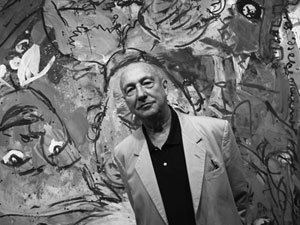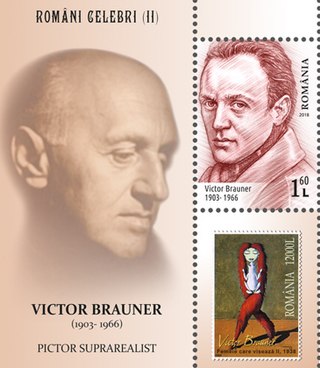
Franz Moritz Wilhelm Marc was a German painter and printmaker, one of the key figures of German Expressionism. He was a founding member of Der Blaue Reiter, a journal whose name later became synonymous with the circle of artists collaborating in it.

Georg Baselitz is a German painter, sculptor and graphic artist. In the 1960s he became well known for his figurative, expressive paintings. In 1969 he began painting his subjects upside down in an effort to overcome the representational, content-driven character of his earlier work and stress the artifice of painting. Drawing from myriad influences, including art of Soviet era illustration art, the Mannerist period and African sculptures, he developed his own, distinct artistic language.

Julius Schnorr von Carolsfeld was a German painter, chiefly of Biblical subjects. As a young man he associated with the painters of the Nazarene movement who revived the florid Renaissance style in religious art. He is remembered for his extensive Picture Bible, and his designs for stained glass windows in cathedrals.

Victor Brauner was a Romanian painter and sculptor of the surrealist movement.

Emmendingen is a town in Baden-Württemberg, capital of the district Emmendingen of Germany. It is located at the Elz River, 14 km (8.7 mi) north of Freiburg im Breisgau. The town contains more than 26,000 residents, which is the most in the Emmendingen district.

The Österreichische Galerie Belvedere is a museum housed in the Belvedere palace, in Vienna, Austria.
Hilmar Friedrich Wilhelm Bleyl, known as Fritz Bleyl, was a German artist of the Expressionist school, and one of the four founders of artist group Die Brücke. He designed graphics for the group including, for their first show, a poster, which was banned by the police. He left the group after only two years, when he married, to look after his family, and did not exhibit publicly thereafter.

The Kunsthaus Zürich is in terms of area the biggest art museum of Switzerland and houses one of the most important art collections in Switzerland, assembled over time by the local art association called Zürcher Kunstgesellschaft. The collection spans from the Middle Ages to contemporary art, with an emphasis on Swiss art.

Paul Schuss is a French artist of the Ecole de Paris. Born after World War II, he is a part of "La Jeune Peinture" de l'Ecole de Paris.

Caspar David Friedrich in his Studio refers to two paintings by the German romantic artist Georg Friedrich Kersting dated 1811 and 1819. Of these the 1819 version, now in the Alte Nationalgalerie in Berlin, is the best known. In both Kersting depicted fellow German painter Caspar David Friedrich in his studio.

The Master of Meßkirch was an anonymous German Renaissance painter.

At the Battle of Emmendingen, on 19 October 1796, the French Army of Rhin-et-Moselle under Jean Victor Marie Moreau fought the First Coalition Army of the Upper Rhine commanded by Archduke Charles, Duke of Teschen. Emmendingen is located on the Elz River in Baden-Württemberg, Germany, 9 miles (14 km) north of Freiburg im Breisgau. The action occurred during the War of the First Coalition, the first phase of the larger French Revolutionary Wars.

The Darmstadt Madonna is an oil painting by Hans Holbein the Younger. Completed in 1526 in Basel, the work shows the Bürgermeister of Basel Jakob Meyer zum Hasen, his first wife, his current wife, and his daughter grouped around the Madonna and infant Jesus.
(Arthur William) Douglas Cooper, who also published as Douglas Lord, was a British art historian, art critic and art collector. He mainly collected Cubist works. He was involved with investigating who had dealt with stolen art during the war. After the war he bought a chateau and converted it into a gallery of early cubist art.

Herdern is a quarter (Stadtteil) of Freiburg im Breisgau in Baden-Württemberg, Germany.

The Portrait of Bernhart von Reesen is a portrait painting by German Renaissance master Albrecht Dürer. It depicts a man wearing a beret and holding a piece of paper against a red background. The oil on panel painting is dated 1521 and is in the collection of the Gemäldegalerie Alte Meister of Dresden, Germany.

Karl Philipp Fohr, a brother of Daniel Fohr, was a German painter, born at Heidelberg in 1795.

Lotte Brand Philip was a German art historian, professor and expert on Netherlandish art, one of the most notable and incisive experts on 14th- and 15th-century art to have studied under Erwin Panofsky. Born a Christian of Jewish descent, she resisted state intimidation to leave Germany, only moving to the United States in 1941. She began her new life as a jewelry designer, before establishing a career as an art historian and writer, and taking professorship at a number of universities, including New York University and Queens College, Flushing. During her long career, Brand wrote highly regarded books and monographs on artists such as Jan van Eyck, Albrecht Dürer and Hieronymus Bosch, and in 1980 became emeritus at Queens. Brand Philip died on May 2, 1986, in New York City.

The Museum of Islamic Art is located in the Pergamon Museum and is part of the Staatliche Museen zu Berlin.

















